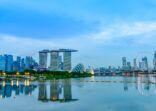Asia is unique in being part of the problem but also the solution, according to professor Lawrence Loh, director at the Centre for Governance and Sustainability at the National University of Singapore’s Business School.
Here he talks about regulation in the region, why ‘ESG’ needs redefining and what investors can be looking out for when it comes to sustainability progress.
What are your perspectives on the sustainability landscape in Asia?
I think as a broad concept, we have passed the formative stage. We have achieved a certain level of maturity, in terms of the usage, and more importantly, in terms of encouraging some of the carbon-intensive companies to adopt as well as disclose sustainability targets. We have gone way beyond whether they should do it, to how they do so.
Having said that, over the next few years to even the next few decades, we will definitely see a very strong momentum, and that I’ll say, is almost irresistible. As long as the sun is there, as long as we continue to emit carbon, and as long as climate has variations, it will be a problem that we have to grapple with.
In my interaction with many corporates, I see that ESG or sustainability is really an integral part of the boardroom as well as embedded and internalised in the corporate structure. While the need is clear, there will be many hurdles along the way. Fundamentally, we are still trying to solve the problem of being a free rider because sustainability is a public good. So now, the problem is that sustainability is short of a market mechanism to ensure that they pay up to the proper price, most of which can only be achieved through regulation.
I feel that in sustainability, because of the fundamental problem of externality, what you regulate is what you get.
Asia stands in a unique position now because it is both the problem as well as the solution. It’s a problem because of the different stages of development, Asian countries need to turn the earth resources into economic uses which advanced countries have done so in the last few centuries, let’s say by converting natural resources into agricultural resources for example. Asia stands at a point where there is a very delicate tension between its ability to keep the natural resources, mainly the forests, intact. Asia has the solution because forests are the greatest assets for carbon absorption. Indonesia’s forests are one of the three biggest lungs in the world, the other two are Amazon forest and Congo forest. The question now is why do developing countries have to pay to keep the forest? So, some developed countries have come together to provide massive funding such as through the L&D (loss and damage) fund set up in COP27 last year.
How has the reporting structure in Asia evolved over the years and how does it compare with the rest of the world?
We all started with a purely economic approach in corporate reporting. After that, it went into social and then environmental. Everything is now integrated into ESG, but I believe it should be EESG, with the first E representing economics. I feel there should be balance, with a calibration for the economy, as ESG should not be seen in isolation.
When we look across the world, we see that in the EU, the pendulum has swung to very intensive regulation. Just this year, the EU sustainability reporting standards were released. Beyond that, for many years, they already have a cap and trade mechanism for carbon emission for companies in energy-intensive sectors. Right now, they are trying do something on conservation through a carbon border adjustment mechanism as they do not want European companies to choose the path of least resistance by outsourcing sustainably to other regions, particularly Asia. So, if they import from Asia with less sustainable practices, they are cheaper at the border so that additional taxes are needed so they don’t exploit the Asian loophole.
It is really hard to crack the EU market. And I think this is exactly what the Asian response should be, if you are really interested in your overseas market, you have going to get into the sustainability game, fast.
Do you believe that greenwashing has a part to play in the development of regulation?
Yes, for sure. There have been certain episodes. There was a case involving a German asset management company, DWS Group, which has been affiliated with Deutsche Bank, misclassifying the assets as ESG. There was another case where a Korean skincare and cosmetics company wrapped their plastic bottles with paper saying “hello, I’m a paper bottle” as part of their advertising campaign. While many members of the public cried foul, it probably also have the perverse effect of enhancing the company’s brand awareness.
So, I think greenwashing is something we need to deal with. The hottest trend now is 2030 net zero declaration and it seems almost fashionable for everyone to jump on the bandwagon. I think we will have to take a more critical look at the target of net zero. To me, what is more important is the transition to the destination, not the destination itself. Stakeholders, as well as investors, must know that net zero will not be achievable 27 years from now, if there is no action plan now. So, you need to design the whole journey of intermediate action, commitment and verification. To reach net zero, the most important part is really for companies to do deep decarbonisation, radically revamp their energy portfolio, and manage their waste and water as part of the whole sustainable value chain.
How do you think investors’ perceptions towards sustainability has been?
Investors are only one part of the equation, but I think they are the most critical part of it for most businesses. This is because, sources of funding are very important and companies need to manage the costs of capital. What I am seeing is many investors are very focused on financial returns. What is needed is we require certain mechanisms that will externally affect their financial position, so that the investor will see the urge to be sustainable. It is very reassuring that the risk exposures for non-sustainable companies have shifted upwards because of transition risks.
The new investor needs to be more aware and set expectations on sustainability, beyond just short-term monetary gains. The key challenge now is how the risk determination can be done especially in the long term – transition risks are really difficult to ascertain as these are somewhat moving targets. Yet, even if we can address the risk aspects, the real difficulty is in the valuation of sustainability actions since traditional methods like looking at future cash benefit streams will not be easily applicable.
What opportunities do you see in the sustainability space in Asia?
Going forward, I think Asia is where the new opportunities for sustainability will be. Asia represents a region where much economic development will take place – this will be where carbon emissions are most intensive. We will need to moderate or even regulate the carbon-intensive activities. As the world, including Asian countries, desire to move towards net zero emissions, much of these will have to be offset if not avoided or reduced at source.
Carbon services, including trading, will come to Asia. China already has a large carbon emission trading market. We will need a hub of sorts to organise and consolidate the carbon activities. Asian locations such as Singapore has already mounted initiatives such as Climate Impact X which is a marketplace and exchange for carbon credits. The carbon economy will be the next big trophy for Asia.
This story first appeared in our sister publication, ESG Clarity.

















